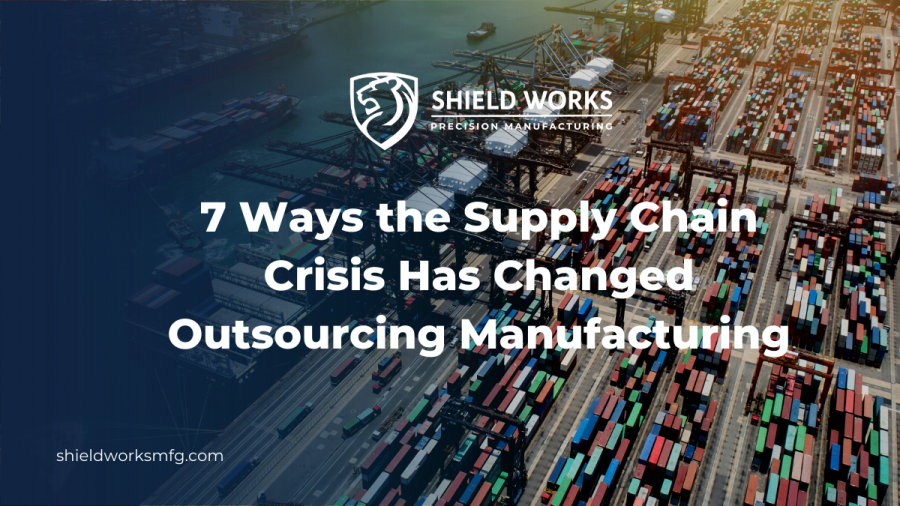7 Ways the Supply Chain Crisis Has Changed Outsourcing Manufacturing

The year 2021 was synonymous with shortages in almost every industry. Across the world, some product shortages meant that shelves were empty and the demand for products outstripped what was available.
This isn’t a problem that’s going away anytime soon. Experts have indicated that global supply chains could be affected for up to two more years.
This is changing the way that companies approach outsourcing manufacturing.
In this article, we will take you through the 7 ways that the supply chain crisis has changed outsourcing manufacturing and what options are available to businesses.
Read on to find out more.
1. Implementing Company Emergency Plans
Company emergency plans are in place for a reason. Supply chain disruptions or breakdowns in production lines can be costly for any business that relies on providing a product or service to customers.
It’s having the infrastructure and policy in place for those ‘what-if’ moments. A contingency plan for different scenarios is critical for those businesses that need to react quickly when something goes wrong.
Whether that’s changing your outsourcing manufacturer, or changing your shipping routes, a plan needs to be in place for every eventuality.
2. Looking Further Afield
The supply chain crisis has had businesses investigating new ways to increase outsourcing. Many companies were unable to rely on domestic assembly lines and factories in 2021 due to the number of workers that were sick or ill from COVID 19.
Booming manufacturing markets in China mean that companies can still get excellent results and products, just overseas.
You don’t even need to feel as if you’re on a different continent. With state-of-the-art technology, you can get direct video footage of your products being prepared in the warehouses.
This means you can have peace of mind when it comes to the quality of your products.
3. Assembly of Products has Become More Challenging
If a company is relying on several components in a supply chain, this is where problems can emerge. If there’s a shortage in one component or product, this slows down the overall build of a device or item.
If the delayed item is integral to the overall build of a product, this means the product can’t be completed and sold to the customer. If there are delays on several components, this can be detrimental to the supply chain.
This is why some companies are moving away from fragmented production lines and looking to streamline all of their product components with one company or warehouse.
It ensures that products aren’t being delayed any further than necessary and that there aren’t any vital pieces missing.
4. Ordering More Products Through Outsourcing Manufacturing to Store
It’s not just consumers that realize they may need to stock up more. Businesses and companies are ordering in and storing more items on a large scale than previously before the pandemic.
With demands for items at an all-time high, it’s important that companies have enough stock to last them for a longer period of time.
Problems in ports and unloading items have also delayed steps in the supply chain. The Suez Canal crisis was estimated to have held up $9.6 billion of trade per day of the blockage. It also affected global oil prices as well as global supply chains for weeks after.
Events such as these are rare, but they can’t be ruled out happening again.
If a company knows their busiest time of year is Christmas, it’s essential that they have the surplus stock ready for November and ready to be shipped domestically.
5. Redesigning Products for Streamlined Production
Some larger companies have gone to great lengths to ensure that they are able to keep up with their outsourced manufacturing. This includes redesigning their products so they don’t have to wait on supply chains for their different components.
Especially in tech products, this is a trend that will continue to develop in the next few years.
Businesses are weighing up their options and working out which is the most efficient way to build their products, without being held up in long supply chain delays.
If there are chip shortages, businesses are shopping around to see what the wait times and price points are.
6. Supply Chain Vulnerability Audits
Companies are trying to learn from their mistakes and supply chain errors of 2021.
Mistakes do happen and it was an unprecedented situation for many businesses, even larger ones that have the necessary capital and infrastructure.
Many companies are now carrying out their own supply chain vulnerability audits. This means that they can pinpoint any weaknesses and gaps and pivot to a more efficient way.
Whether this is changing their outsourcing manufacturer or ordering products on a larger scale, it’s important that mistakes can be used as a learning experience.
7. Adjusting Targets for Production
If your production and output were drastically down for 2021, that’s something that was true for a lot of companies the world over.
Nintendo, for example, was short of its production target due to supply chain issues. The simple fact is, you can’t finish a product if you don’t have all the pieces for the job.
Supply chain problems aren’t going away any time soon. It can be helpful to make reasonable adjustments to your production targets to combat this global issue.
Outsourcing Manufacturing: What Can You Do for Your Business?
The supply chain crisis is the result of a myriad of problems, in conjunction with the pandemic. One way to combat this is to reevaluate your outsourcing manufacturing.
Take a look at the services we can offer your company, from manufacturing to assembly to warehousing.
We’re a reputable manufacturing company with 16 years of experience in the field.
Fill in our contact form and one of our expert team will get back to you shortly. We look forward to making your outsourcing manufacturing a lot more straightforward.
